We have proposed a tactile geometry display technique
based on perceptual feature of the finger movement.
The display moves a plateau during finger movement,
and presents continuous surface and realistic edge.
We call the principle "Moving Plateau Touch Display (MPTD)"
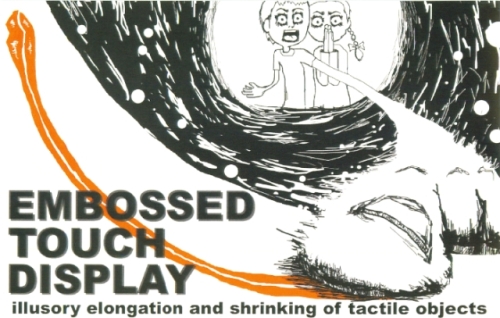
Picture by Eisuke
Kusachi
When we present this display at SIGGRAPH2006,
it was named "Embossed
Touch Display".
Hideyuki Ando (NTT
Communication Science Laboratories)
Junji Watanabe (PRESTO JST /NTT Communication Science Laboratories)
Masashi Nakatani (The University of Tokyo)
Tomohiro Amemiya ((NTT
Communication Science Laboratories)
Taro Maeda (Osaka University)
Principle
of Embossed Touch Display
2
Dimensional Shape Presentation
An object can move along the two orthogonal axes.
|
Principle |
| When humans touch an object in a space, even if the object is larger than the fingertip, we can perceive its size and shape due to the finger movement. We have proposed a tactile geometry display technique based on such active finger movement. We use a perceptual feature where, during the finger movement, the width of a touched object is perceived to increase when the object is moved in the same direction as the finger movement (as shown in Fig 1(a))or to shrink when it is moved in the opposite direction (as shown in Fig 1(b)). With this display technique, called the Moving Plateau Touch Display (MPTD), a wide range of tactile shapes can be presented with realistic rigid edges and continuous surfaces, which are difficult for prior tactile devices to present. |
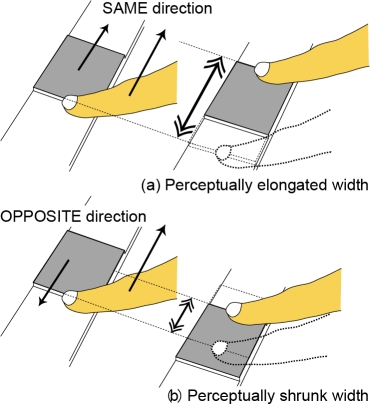
Figure 1
|
The MPTD was achieved by advanced object control performed in accordance with measured hand movements. We implemented the display with a laser distance sensor and a liner slider. The sensor measures the distance between it and the finger, and liner slider is controlled in accordance to the distance. Using this display, we can present realistically rigid edges. We can also present continuous surfaces, which is difficult for prior tactile devices.
|
|
2D Visual-Tactile Display |
|
The MPTD moves part of the real material on the slider to present tactile geometry information according to finger movement.
It can therefore present not only realistically rigid edges but also continuous surfaces, which are difficult for prior tactile devices to present. Two-dimensional display The display technique, shown in Fig. 1, can easily be extended to a two-dimensional (2D) shape display by moving the object along two orthogonal axes. Any kind of smooth shape can be generated by moving a round object two-dimensionally. (Fig. 2) Visual-tactile display In addition to the tactile function, we integrated the ETD with a visual image presentation function. As shown in Fig. 3, when a piece of transparent material is placed on a transparent screen and the image is projected from the back of the screen, the edge of the tactile object on the screen aligns with the edge of the visual image. When the user moves his/her finger on the image, the visual image doesn't move, and the tactile transparent material is moved synchronously with the finger movement (The speed of the object is controlled according to the size of the displayed visual image). Then, the visual and tactile edges of the presented object can overlap. (Fig. 3) |
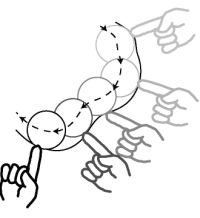
Figure 2
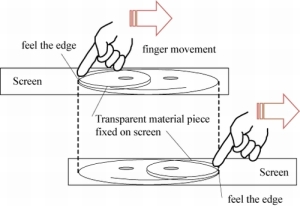
Figure 3
|
Implementation |
| Figure 4 shows the MPTD display device implemented. The transparent screen moved along the two orthogonal axes. Shaft motors were used for the translational move-ment actuator, because this motor provides high thrust output without gears. One shaft motor (S160D, GHC Ltd.) was used in the horizontal direction, and two parallel shaft motors (S080Q, GHC Ltd.) were used for the vertical direction. We used a small rotary encoder (MES6PC, MTL Inc.) for the positional sensor. The projector was fixed under the shaft motors, and visual images were projected onto the screen. The projected image could be controlled regardless of the movement of the screen. Transparent material is attached on the screen for presenting tactile information. |
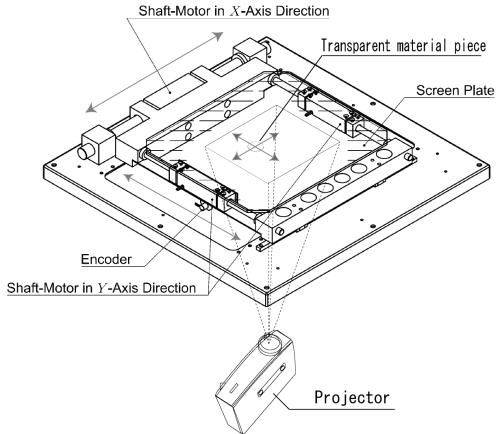
Figure 4
| Contact: junji.watanabe.sp@hco.ntt.co.jp |